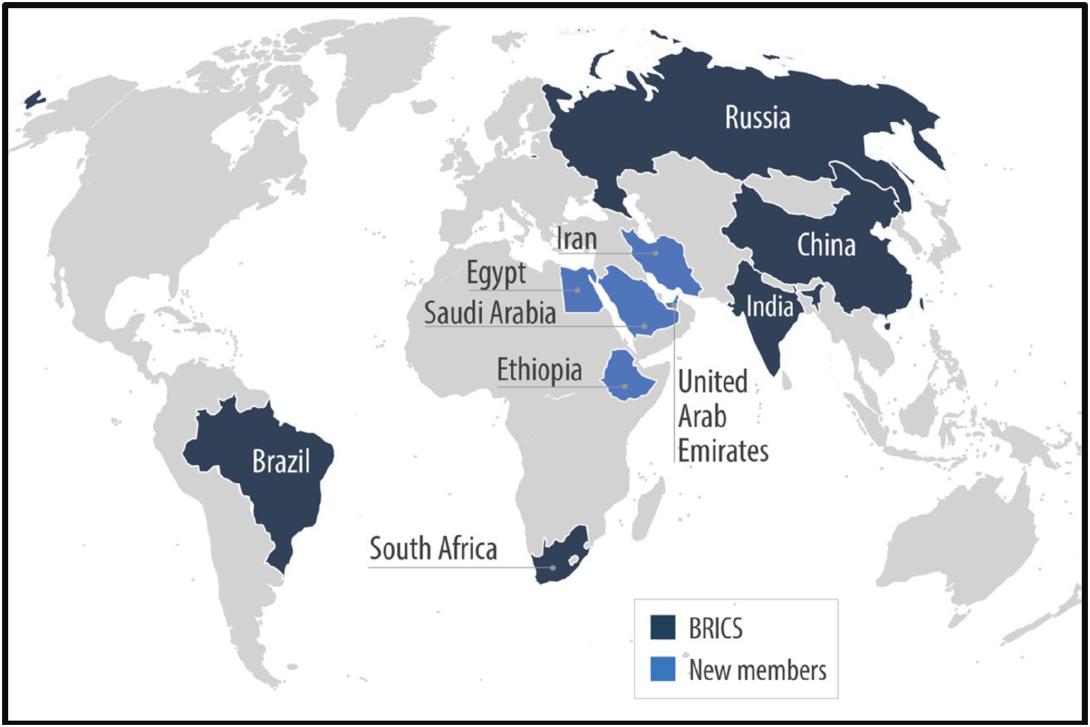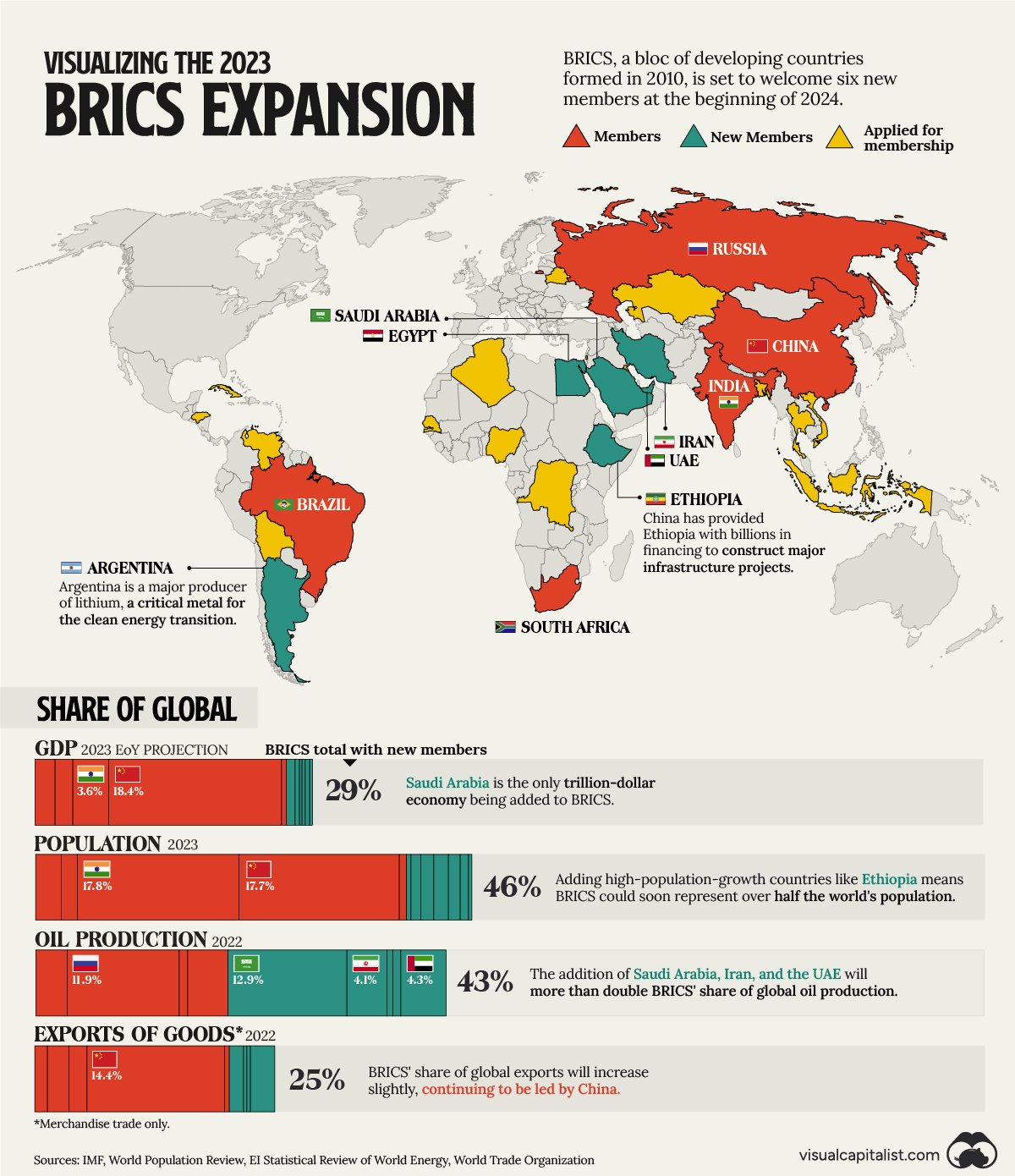
The population of about a combined more than 3.5 Billion or 45% of the world's inhabitants 1
(Table 1), united under the umbrella of BRICS for obvious reasons. The rationality behind this
union is, of course, each country's national interest to achieve maximum for their nation.
Individuals and countries unite for personal interest, which consequently helps each other. For
instance, on an individual basis, a man delivers pizza for his income, which is his interest, while
his act fulfils someone else's stomach. The receiver pays the bill so that he can collect the
parcel, which is his food, while the money he pays becomes the income of the delivery boy.
Both persons perform actions for their interests while helping each other intentionally or
unintentionally. In terms of countries, they do business or exchange currency which in return
helps them in one way or the other. Hence, working for oneself benefits the other also.
The very same concept goes for countries' unions, they follow the national interest theory
when forming a union. Countries follow the idea that states act following their national
interest. This interest includes self-preservation, economic growth, and military strength.
Sometimes, two or more states have the same interest which forces them to unite for that
purpose. Fighting against the enemy, like THE ALLIES and THE CENTRAL POWER in World War I,
achieving economic prosperity and military strength, like the European Union after WWII and
many more.
BRICS was founded for the same reason and against the Western powers to create a multi-polar
world, to disintegrate the Western allies, and to create a new world order which makes the
option for the small or least developed or developing countries to choose the option. In 2006
Brazil, Russia, India, China, and South Africa in 2010, adding S to the BRICS, allied together and
established the BRICS. This group was designed to unite the world's most developing countries
to challenge the European and North American allies' economic and political power. After the
enlargement of BRICS, Iran, Saudi Arabia, UAE, Egypt, Argentina, and Ethiopia joined this union
which named it BRICS+. The BRICS+ economy is combined with more than $28.5 trillion or 28%
of the global economy 2 (Figure 1).
1 https://data.worldbank.org/indicator/SP.POP.TOTL?end=2022&locations=BR-RU-IN-CN-ZA-SA-AR-EG-ET-IR-AE-
1W&most_recent_value_desc=true&start=2020
2 https://data.worldbank.org/indicator/NY.GDP.MKTP.CD?end=2022&locations=BR-RU-IN-CN-ZA-SA-AR-EG-ET-IR-
AE-1W&start=2020

The establishment of BRICS is the counterweight to the Western-led world. The grievances of
developing countries are related, BRICS countries have combined $26 trillion, or 60 per cent of
the G7 countries’ combined GDP, and BRICS countries' GDP accounts for 31.5 per cent of the
global economy while G7 countries account for 30.4 per cent of the world economy, BRICS
overtaking the G7. However, BRICS countries get 15 per cent voting power in International
Monetary Funds 3 , this inequality in power forces developing economies of the South to unite
and become a strong voice.
In 2015, the New Development Bank was established, it aimed to provide an alternative
International Financial system to the developing economies, the IMF and World Bank have
been under the US-led hegemony. It also aimed to become the greater voice and
representation of Global South lending money to boost infrastructure and it also provided $32
billion by the end of 2022 to emerging nations to build roads, railways, and water supply
projects 4 .
The establishment of the New Development Bank (NDB) showed the Global South that is not
impossible to challenge the Western-led financial institution architecture, said Sanusha Naidu, a
senior research fellow at the Institute for Global Dialogue, a South African think tank focusing
on China and Africa. In addition to the US sanction threat, “BRICS PAY” was introduced which
allowed countries to do transactions among BRICS countries without converting local currencies
to dollars. However, the NDB has not yet ended its dependency on dollars completely.
BRICS has positioned itself as a formidable competitor to the G7 on the global stage,
introducing a variety of initiatives aimed at redefining the financial and geopolitical landscape.
These include the establishment of the New Development Bank, the creation of the Contingent
Reserve Arrangement(CRA), the development of a BRICS payment system, and the publication
of joint statistical data. Additionally, the bloc has proposed the idea of a BRICS basket reserve
currency and has been vocal in advocating for a stronger presence within the IMF, particularly
as their collective GDP has overtaken that of the G7.
For emerging economies that have faced challenges with the IMF's stringent structural
adjustment policies and austerity measures, BRICS offers a promising alternative. By promoting
commercial ventures that support social, economic, and environmental infrastructure, BRICS
directly counters the influence of the G7. These initiatives not only strengthen the bloc
internally but also attract interest from other nations looking for new opportunities and
partnerships outside of traditional Western-dominated frameworks.
3 https://www.atlanticcouncil.org/blogs/new-atlanticist/china-and-india-are-at-odds-over-brics-expansion/
4 https://www.bbc.com/news/world-66525474
The emergence of BRICS is the creation of rivalry in the world. It has shattered the hegemony of
G7 countries in terms of economy and global dominance, it has created a Bi-polar world for
developing countries which did not have that option before. BRICS has been competing with G7
in terms of economy, population, financial institutes, and military strength.
BRICS+ countries have a 29% global share of GDP compared to the G7, while the later countries
have a 43% global share of GDP (Table 3). Several current BRICS members are already
experiencing faster real GDP growth compared to their G7 counterparts. According to Goldman
Sachs, the average GDP growth of BRICS members is projected to increase by 189% by 2050, in
contrast to the G7's average growth of just 50%.
Newly added members, such as Ethiopia and Egypt, are projected to see even more dramatic
economic growth. Ethiopia’s GDP is expected to grow by 1,170% by 2050, while Egypt's is
forecasted to rise by 635%, significantly boosting BRICS’ overall economic potential.
Goldman Sachs further predicts that by 2050, BRICS will surpass the G7 in terms of GDP, even
without factoring in its new members. While it remains to be seen if these forecasts will
materialize, BRICS' continued expansion suggests that the bloc is on track to outpace the G7
economically in the coming decades 5 .

Countries like Brazil and India prefer economic growth over the expansion of BRICS, contrary to
the opinion of China and Russia which prefer the latter idea. Brazil and India do not want to
lean to completely one side either, neither China nor USA, they only want economic options for
their respective countries. They are still dependent on a Western-led system, they can’t shift to
China or Russia directly nor do they want to. This will make them dependent on the South, they
want options for diplomacy since it’s the nature of international relations.
The majority of the countries of BRICS+ are also part of G7; they all try to balance the two
unions. One, G7, is led by Western powers, while the second, BRICS+, is led by the Southern
powers. Developing countries that are part of the unions try to avoid siding with anyone
because of the creation of a Bipolar world, which is beneficial for developing economies.
Humans, in general, can’t live without social networks. They started living together to cope with
danger, environmental challenges, and food insecurities. Social responsibilities were shared so
that a prosperous society could have all basic needs. Some provide security to the network
while others prepare food which all can share. This was also an example of national interest but
on an individual basis. We can conclude that in pursuit of personal interest, individuals started
living in a society.
5 https://www.visualcapitalist.com/charted-comparing-the-gdp-of-brics-and-the-g7-countries/
Countries also need allies for trade, protection in case of war with the enemy, and support for
mutual benefits.

Pakistan sought membership in BRICS last year to become a voice of the global south and a part
of the emerging world order called regionalism. Pakistan’s joining of BRICS was speculated
earlier but due to immense dependency on the IMF, the World Bank, and other institutes
Pakistan’s policies can’t be determined or speculated easily. Last year, in November, Pakistan
applied for membership in BRICS. The foreign ministry spokesperson said, “We believe that by
joining BRICS, Pakistan can play an important role in furthering international cooperation and
revitalizing inclusive multilateralism, We also hope that BRICS will move forward on Pakistan’s
request in line with its commitment to inclusive multilateralism”.
However, Pakistan’s way is blocked by India, its arch-rival, India will use its full power to stop
Pakistan from joining. India’s relations with China are also not in favourable condition while
Pakistan’s relations with China are a long rock-solid relationship which can create an influence
of Pakistan in BRICS, that’s why India opposition Pakistan's addition because of duo of Pak-
China DOSTI. Contrary to China and India, Russia is neutral, and Russia’s nod would create a
positive chance for Pakistan to join. Pakistan Ambassador to Russia Muhammad Khalid Jamali in
an interview with TASS, said Pakistan plans to join the group next year, under Russia’s
presidency and added that Islamabad was in contact with member countries for support of the
country’s membership but counted on Russia’s assistance 6 .
Seeking membership means Pakistan acknowledges the influence of BRICS+, and its economic
and political influential strengths have been recognised by the whole world. BRICS+ share of
GDP, oil production, population majority, and net export have been increasing significantly
since 2010 (see Figure 2). Pakistan, like many other developing nations, wants to be a part of
the union that welfares the country in terms of economy, and become a voice of the region
against the Western powers.
Pakistan is also part of the CPEC, since 2016, which is under the Belt Road Initiative (BRI) of
China. Due to political instability, CPEC has fluctuated but overall both nations are keen to work
together for their respective economic interest. CPEC includes infrastructure(roads, railways,
and highways), energy projects, and job creation.
Acquisition of membership in BRICS+ would be very helpful for Pakistan in terms of economics.
Pakistan is not satisfied with the stringent conditions imposed by the IMF and World Bank, by
joining BRICS, Pakistan can have the option of a New Development Bank and Contingent
Reserve Agreement (CRA). CRA has more than $100 billion in capital, which can help develop
economies during payment crises 7 .
6 https://tribune.com.pk/story/2447642/pakistan-plans-to-join-brics-next-year
7 https://moderndiplomacy.eu/2023/10/01/why-brics-matters-for-pakistan/
Once it joins BRICS+, Pakistan can explore more export markets and benefit from trade with
emerging economies. By exploring new markets, Pakistan can reduce its unemployment,
illiteracy, and poverty.
The BRICS platform would provide an opportunity for Pakistan to participate in global policies
concerning Pakistan. Pakistan has been blackmailed by superpowers, and inclusion in BRICS
would make Pakistan’s vote influential. Pakistan can shift its diplomatic stance, gradually, and
can direct foreign policy objectives correctly. Since 9/11 Pakistan has been considered a terror
state, Pakistan can use the BRICS platform to show its soft image to the world.
If Pakistan goes along with both the powers, like India, it will be easy for her to take advantage
of both options, the US and China, while remaining in the middle would be difficult in the long
run since the CPEC project and BRICS+ membership seeking showed where Pakistan looks for in
future. For now, Pakistan can maintain ties with both powers since it needs time for its political
and economic stability.
Regionalism has been increasing significantly recently, and small countries in groups become a
strong voice in the global world. Since after the fall of the USSR, the liberal world order became
the sole leader of the globe, but, after the rise of China, the world order has shifted. BRICS is
the outcome of the shifting world order, developing countries need representation on the
international platform. China’s foreign policy of non-interference in internal matters has
attracted many countries which were blackmailed in the past by the US for its interest.
Members of the BRICS+ countries, by 2050, will be much better in position compared to the G7
countries in terms of GDP, population, military strength, net export, and energy production.
Pakistan’s application for BRICS membership is considered a positive for its foreign policy.
Exploration of different markets for its exports, non-interference policy of BRICS,
representation in the world, and a part of the future world order would help Pakistan in every
term. However, its path is blocked by India, and this will require diplomacy to pressure India
through other member states. Pakistan's accession to BRICS would be beneficial for the region
since it will reduce tension between India and Pakistan, which has been for more than 70 years
in this region.
Footnote Sources:
1- https://data.worldbank.org/indicator/SP.POP.TOTL?end=2022&locations=BR-RU-IN-CN-ZA-SA-AR-EG-ET-
IR-AE-1W&most_recent_value_desc=true&start=2020
2- https://data.worldbank.org/indicator/NY.GDP.MKTP.CD?end=2022&locations=BR-RU-IN-CN-ZA-SA-AR-
EG-ET-IR-AE-1W&start=2020
3- https://www.atlanticcouncil.org/blogs/new-atlanticist/china-and-india-are-at-odds-over-brics-expansion/
4- https://www.bbc.com/news/world-66525474
5- https://www.visualcapitalist.com/charted-comparing-the-gdp-of-brics-and-the-g7-
countries/
6- https://investingstrategy.co.uk/financial-news/brics-vs-g7-head-to-head-comparison-
and-statistics/
7- https://tribune.com.pk/story/2447642/pakistan-plans-to-join-brics-next-year
8- https://moderndiplomacy.eu/2023/10/01/why-brics-matters-for-pakistan/


